Skin Conditions
Skin conditions, what they are and how you can treat them.
Do you have a skin condition and need guidance? At Positive Skin, we provide information about various skin conditions, including how to identify them and what factors contribute to their development. Additionally, we offer advice on home remedies and the benefits of in-clinic treatments.
Pigmentation
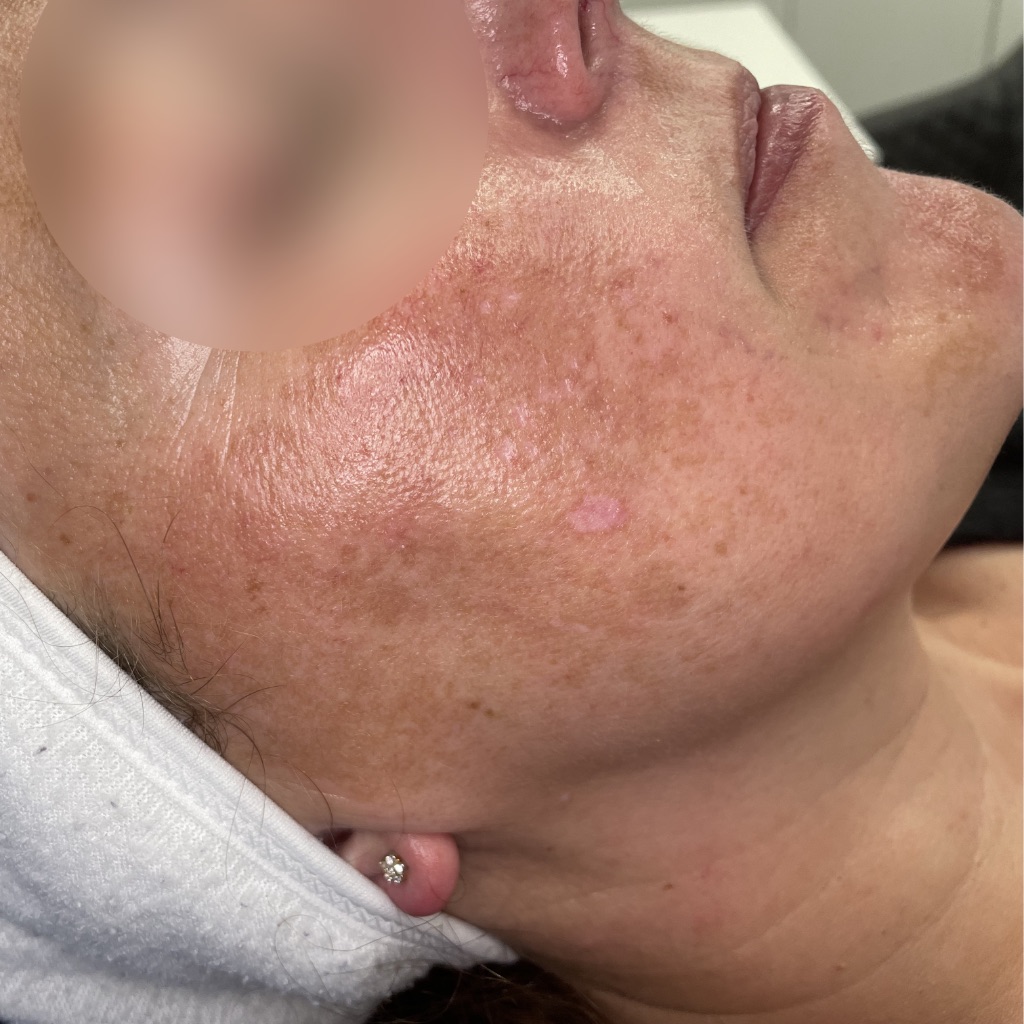
All About Pigmentation in the Skin: Causes, Treatment, and Prevention
Pigmentation in the skin is an issue that affects people of all skin types. It can cause areas of the skin to be darker than usual or to have discoloured patches. An overproduction of melanin causes hyperpigmentation.
This pigment gives the skin its colour and can be caused by various factors, including sun exposure, hormones, or genetics. Pigmentation can be treated with different methods, including chemical peels, IPL/ laser treatments, and topical treatments.
Defining Pigmentation
Pigmentation can occur anywhere on the body, but it is most commonly seen on the face, hands and arms. It can affect people of all ages and skin tones, but those with darker skin tones are more likely to experience pigmentation.
Pigmentation has many causes, including hormonal changes (such as during pregnancy), overexposure to the sun, genetics and certain medications. Sometimes, it can also be caused by skin conditions such as eczema and psoriasis – see the inflammation/rosacea page for more information.
Common Causes Of Pigmentation
1. Melasma or Chloasma: This type of pigmentation is caused by hormonal changes, most commonly due to pregnancy. It is characterised by dark patches of skin on the face, chest, and arms. It usually goes away within a year or two after the pregnancy, but in some cases, it can stay longer or become permanent.
2. Environmental Pigmentation: Also known as sun damage or age spots, this type of pigmentation is caused by excessive exposure to UV rays from the sun. Unprotected exposure to the sun can cause premature ageing and dark spots on the skin.
3. Post-Inflammatory Hyperpigmentation: This type of pigmentation is caused by skin inflammation due to injury or certain medical conditions. It is characterized by dark spots that appear after an injury, such as acne scars, cuts, burns, etc.
Treatments For Pigmentation
These treatments are safe and effective options for treating pigmentation and can help restore your skin’s natural colour and texture. However, speaking with a professional skin therapist is essential to ensure you get the right treatment for your skin type and condition.
Prevention Of Pigmentation
Other ways to prevent pigmentation include avoiding harsh skin products, such as those that contain retinoids and acids, which can cause skin irritation and trigger pigmentation. Smoking has also been linked to causing pigmentation in some people, so quitting smoking is also essential for preventing pigmentation. A healthy diet, full of antioxidants and vitamins, can help promote healthy skin and reduce the risk of developing pigmentation.
Anti-Ageing
How to Deal With Premature Ageing Skin
As we age, our skin naturally loses some of its elasticity and youthful glow. But for some of us, the signs of ageing can appear much earlier than expected. Various factors, including environmental stressors, genetics, and lifestyle choices, can cause premature skin ageing.
If you are struggling with premature ageing skin, the following will provide some helpful tips and advice on how to care for your skin and reduce the appearance of wrinkles, lines, and other signs of ageing. Read on to learn more about how to deal with premature ageing skin.
How Does Skin Age – Intrinsic And Extrinsic
Our skin constantly changes, becoming thinner, drier, and less elastic as we age. Two main factors influence how quickly our skin ages – intrinsic and extrinsic.
Intrinsic factors are internal factors, such as our DNA and lifestyle habits, which account for 20% of our skin ageing. Intrinsic factors include things like genetics, hormones, and general health conditions. Our genetic makeup determines our skin type and texture and influences how we age. Hormonal changes can also play a role in skin ageing, affecting the production of oil, collagen, and elastin.
Extrinsic factors are external factors, such as the food we eat and medications we take, and environmental factors like pollution and UV radiation. This accounts for 80% of our skin ageing. Common extrinsic factors that cause premature skin ageing include smoking, excessive sun exposure, air pollution, poor diet, lack of sleep, and stress. These factors all contribute to the breakdown of collagen and elastin, essential for keeping skin healthy and youthful.
Understanding the difference between intrinsic and extrinsic factors is essential to care for our skin as we age. By understanding how each factor affects our skin, we can make informed decisions about the best ways to look after our skin.
Taking care of your skin at home and maintaining a good skincare routine is the most important factor for protecting against premature ageing. You can take several steps to ensure your skin remains healthy and youthful. First, it is essential to use products that contain both retinol and vitamin C. Retinol helps to speed up cell renewal, while vitamin C helps to protect against environmental damage.
In addition, it is essential to use sunscreen with an SPF of at least 30 and labelled “broad-spectrum” to protect against both UVA and UVB rays. SPF is critical if you have age spots since they can be made worse by too much sun exposure. Using a tyrosinase inhibitor for those with age spots can help reduce these spots’ appearance. These inhibitors block the enzyme tyrosinase, which helps to produce melanin and can lead to age spots forming.
In addition to a good skincare routine, it is vital to maintain a healthy lifestyle. It would help if you ate a healthy balanced diet. Getting enough Vitamin C, iron, calcium and omega 3 & 6 helps to support the skin internally. Avoiding excessive alcohol consumption and not smoking can help keep the skin youthful.
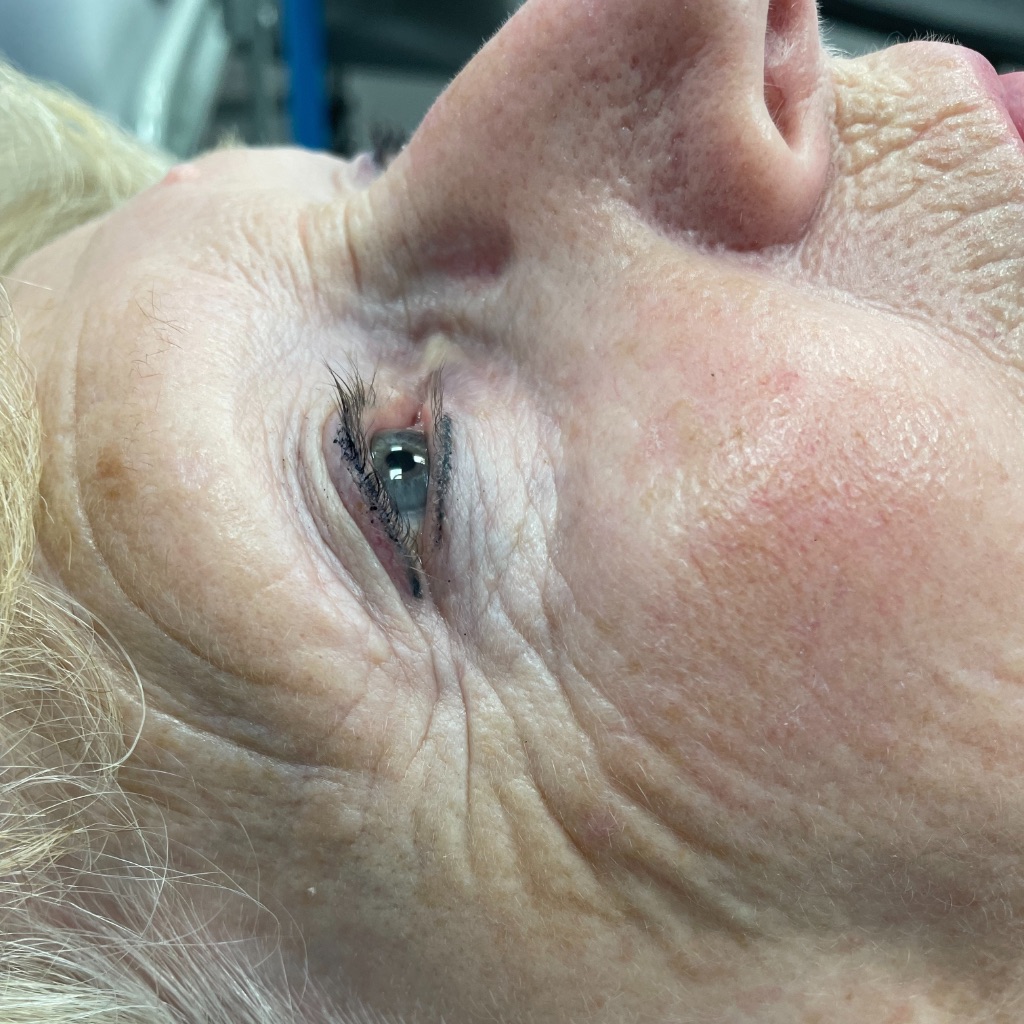
Treatments That Can Help Age Management
Light Emitting Diode (LED) is a form of light therapy that can help reduce inflammation, boost collagen production and brighten the skin. LED uses different wavelengths of light to target the underlying issues and help the skin to repair itself. This treatment is ideal for addressing fine lines, wrinkles, acne, pigmentation, rosacea and more.
Also known as micro-needling, this treatment involves using a pen-like device that contains many tiny needles. These needles puncture the skin and stimulate collagen production, which can help reduce wrinkles and improve the skin’s texture. The result is smoother, younger-looking skin.
Enzyme facials are a type of facial treatment that involve the use of enzymes and other ingredients to boost lymphatic drainage, stimulate blood circulation and encourage the overall detoxification of the skin. This type of facial can also help to firm the skin and reduce the appearance of wrinkles and fine lines.
Intense Pulse Light (IPL) is a powerful light therapy used to treat age spots and other signs of skin ageing. This treatment targets and destroys melanin in the skin, leaving behind a brighter, more even complexion. IPL can also help to reduce redness and decrease pore size.
Overall, various treatments can help with age management, from LED to needling to enzyme facials to IPL.
Finding the right treatment plan depends on your skin’s needs and goals. Consult a professional before undergoing these treatments to ensure safety and optimal results.
Ongoing Support
The ageing process is continual, so it’s important to have ongoing support and care to maintain the results of any treatments you may have had. This involves continuing with a healthy lifestyle and eating habits, in addition to a home skincare routine and occasional maintenance treatments.
Your home skincare routine should focus on hydration and protection. Use a gentle cleanser and exfoliant to remove dirt and dead skin cells, followed by a moisturiser and SPF for sun protection. Many products are available that can help keep the skin hydrated and nourished, such as facial oils, serums and masks.
It’s also important to get regular check-ups with your skin therapist. Routine appointments will ensure that any changes to your skin are noticed quickly, and the appropriate treatment is given.
Following a tailored plan that considers your lifestyle and skin type can help keep your skin looking its best in the long term. With ongoing support and care, you can maintain the results of any treatments you may have had and keep your skin looking youthful and healthy for years to come.
Dry Skin
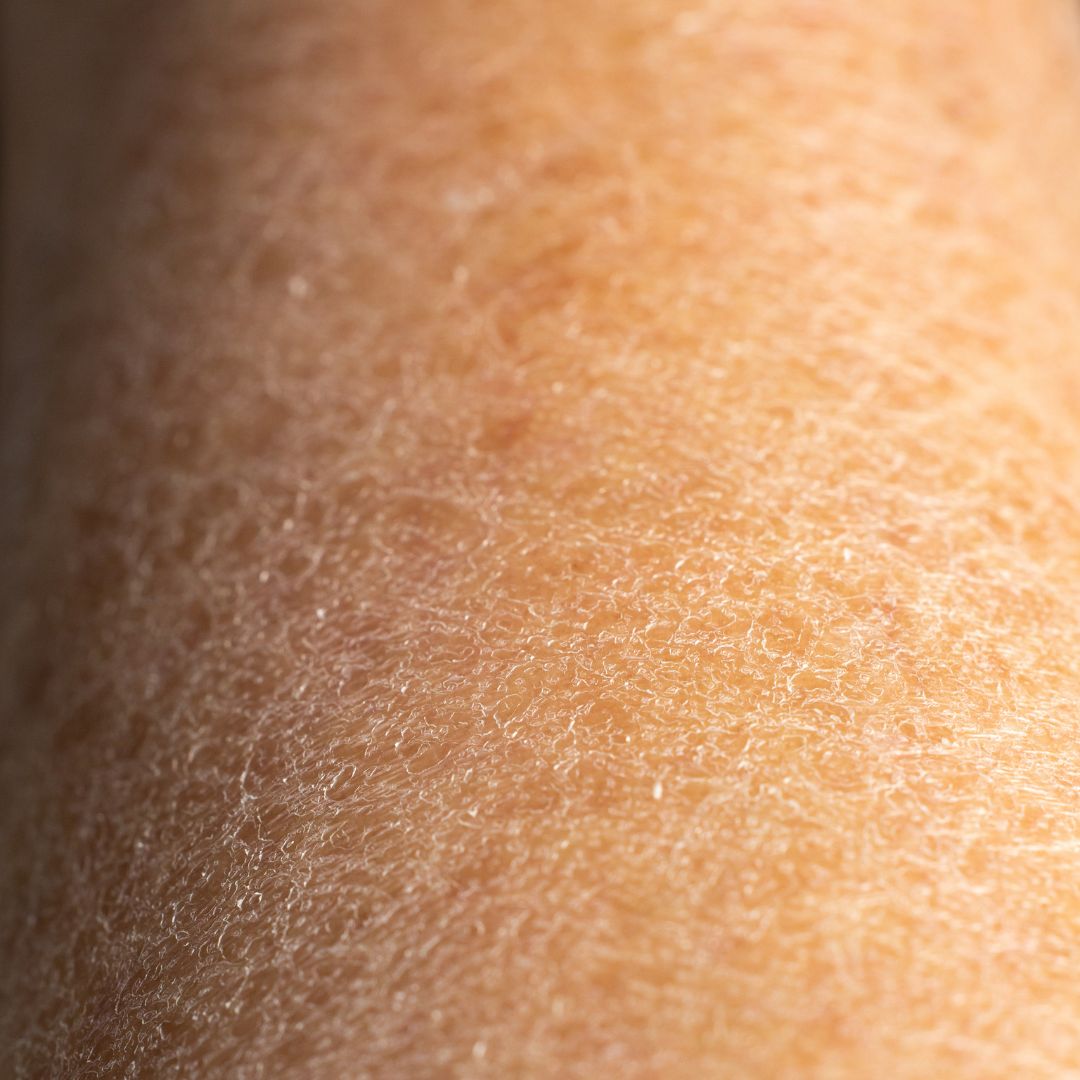
The Different Causes Of Dry Skin And How To Treat It
Dry skin can be a nuisance, leaving skin feeling tight and uncomfortable. It can have a variety of causes, from genetics to environmental factors, and it can be challenging to figure out what’s causing it.
Fortunately, there are treatments available that can help alleviate the dryness. We will explore the different causes of dry skin and discuss how to treat it.
Hereditary
Dry skin can be hereditary. Hereditary means that you may be more prone to having dry skin due to your genetic makeup. This type of dry skin is usually most noticeable on the arms, legs, and hands. It can often cause the skin to become scaly, rough, and itchy.
In some cases, hereditary dry skin can also lead to other skin conditions, such as eczema. Eczema is a chronic condition that causes patches of itchy, inflamed skin to develop. The cause of eczema is unknown, but research suggests that genetics play a role in its development.
However, you can still reduce the effects of dry skin by using moisturising creams and lotions regularly. Additionally, consider using natural remedies, such as coconut oil or aloe vera gel, to keep your skin hydrated and soothe any itching or irritation.
The Different Causes Of Dry Skin And How To Treat It
Dry skin can be a nuisance, leaving skin feeling tight and uncomfortable. It can have a variety of causes, from genetics to environmental factors, and it can be challenging to figure out what’s causing it.
Fortunately, there are treatments available that can help alleviate the dryness. We will explore the different causes of dry skin and discuss how to treat it.
Hereditary
Dry skin can be hereditary. Hereditary means that you may be more prone to having dry skin due to your genetic makeup. This type of dry skin is usually most noticeable on the arms, legs, and hands. It can often cause the skin to become scaly, rough, and itchy.
In some cases, hereditary dry skin can also lead to other skin conditions, such as eczema. Eczema is a chronic condition that causes patches of itchy, inflamed skin to develop. The cause of eczema is unknown, but research suggests that genetics play a role in its development.
However, you can still reduce the effects of dry skin by using moisturising creams and lotions regularly. Additionally, consider using natural remedies, such as coconut oil or aloe vera gel, to keep your skin hydrated and soothe any itching or irritation.
Environmental
Our environment can also be a significant factor in dry skin. The weather can take a toll on our skin. Cold, dry air can remove moisture from the skin, leaving it feeling dry and tight. Central heating systems can also reduce the humidity in our environment, making skin even drier. Harsh exfoliating products can strip away natural oils from the skin, leaving it feeling dry and uncomfortable. As we age, our skin loses its ability to produce enough sebum to keep it moisturised. This is why keeping your skin hydrated is essential regardless of your age.
Using a good moisturiser daily, especially after showering or bathing, is vital in keeping your skin soft and supple. You can also avoid hot showers and baths, use gentle cleansers, and avoid skincare products containing alcohol or fragrances. And do not over-exfoliate your skin, as this can cause sensitivity.
Skin Disorders
Certain skin disorders can also lead to dry skin. One of the most common is eczema, an itchy, red rash that can appear anywhere on the body. It usually occurs in areas where the skin flexes, such as the elbows and knees. Eczema is often caused by a combination of genetics and environment, including allergies and irritants.
Another condition that can cause dry skin is ichthyosis. This condition is characterised by thickened patches of scaly, dry skin on the arms, legs, and torso. It is often inherited and cannot be cured, but the condition can be managed with moisturisers and topical treatments.
Hormonal
Hormones are chemical messengers that help regulate the body’s functions. They affect mood, growth, metabolism and reproduction. When hormones are out of balance or not functioning correctly, it can have an impact on the skin. Hormonal imbalances can cause the skin to become dry, irritated, or even inflamed.
Stress, diet, and exercise all play a role in producing hormones. When stress is high, hormone production can be thrown off balance, leading to dry skin. Eating a balanced diet rich in essential vitamins and minerals can help ensure hormones stay balanced and skin stays healthy. Exercise helps to regulate hormones and can help maintain the skin’s hydration levels.
If dry skin persists despite lifestyle changes, it may be time to see a skin therapist.
How You Can Help Dry Skin At Home
Dry skin can be very uncomfortable and lead to further skin issues like irritation and cracking. Fortunately, there are several things that you can do at home to help reduce the discomfort of dry skin and keep it from becoming worse.
First, try incorporating some home remedies into your routine. Aloe vera gel is an excellent moisturiser for dry skin and can be applied directly to the affected area. Oatmeal baths are also highly effective for hydrating skin, as oatmeal contains several compounds that can soothe inflammation and irritation.
You can also invest in a humidifier to add more moisture to the air in your home. This can help reduce dryness, particularly in the winter when the air tends to be drier due to heating. Additionally, omega-3 supplements can increase your body’s natural production of sebum, the oil that keeps skin soft and supple.
By implementing these strategies at home, you can start seeing an improvement in your dry skin and reduce the discomfort associated with it.
How A Skin Therapist Can Help
A skin therapist can help with dry skin in several ways. They will start by assessing the individual’s skin type and condition to determine the underlying cause and create a treatment plan tailored to the patient’s needs.
The treatment plan may include a combination of highly active products and treatments such as Mesotherapy, Microneedling and enzyme treatments. These treatments help to replenish lost moisture, strengthen the skin’s barrier function and reduce the appearance of wrinkles and lines.
In addition to the treatments, your skin therapist will recommend an at-home skincare routine that includes a cleanser, moisturiser and other products specifically chosen to nourish dry skin. This homecare routine should be performed daily to help keep skin soft and hydrated.
Your skin therapist will also provide guidance on adjusting lifestyle factors contributing to dry skin, such as diet, exercise and stress levels. By following the recommendations of your skin therapist, you will be able to maintain healthy, hydrated skin.
Understanding Dermatitis & Eczema
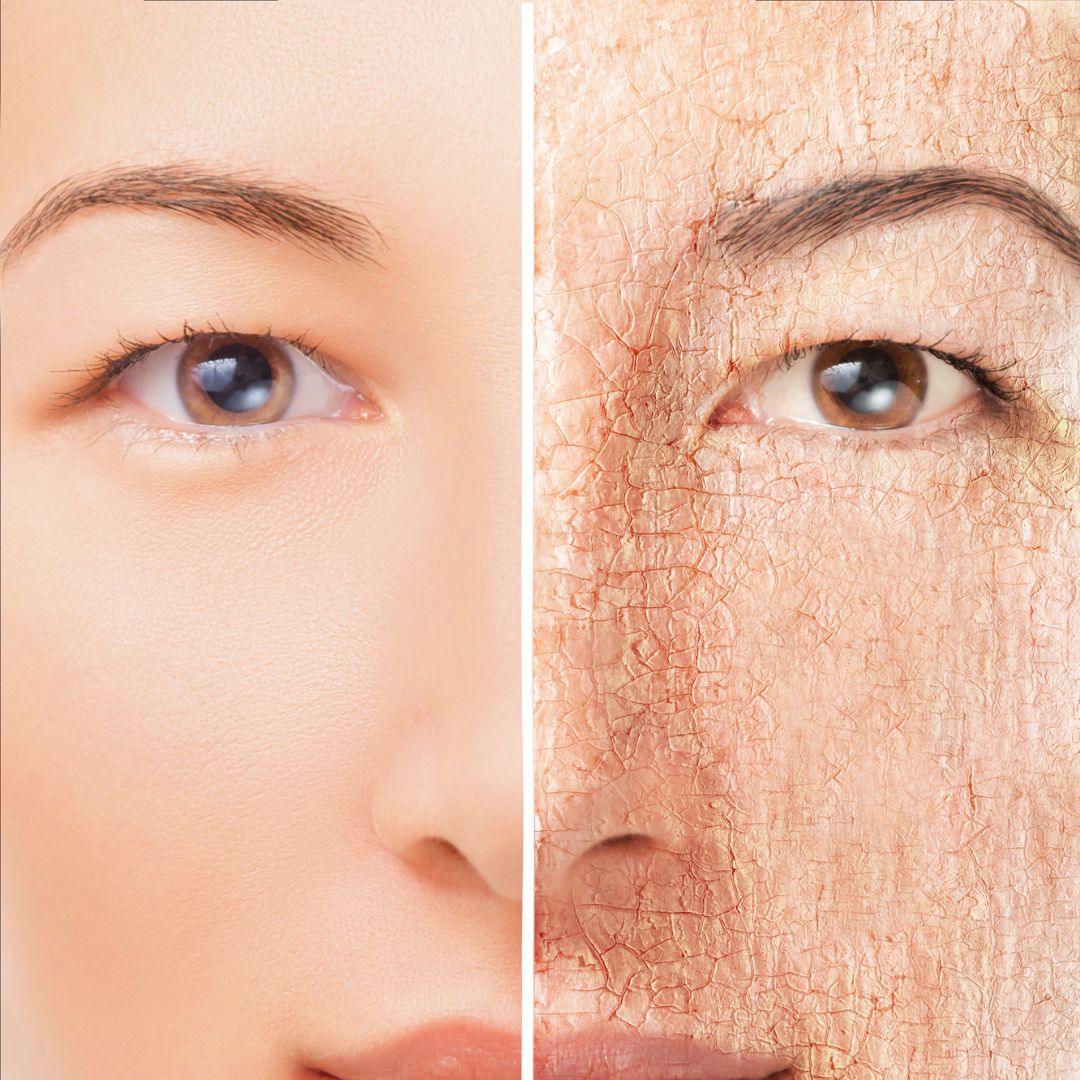
Dermatitis and eczema are commonly used to describe various skin conditions that lead to redness, itching, inflammation, and discomfort. While they are often used interchangeably, dermatitis is a broader term encompassing multiple forms of skin inflammation, including eczema.
In this article, we will explore the differences between dermatitis and eczema, understand what causes these conditions, and delve into practical methods for treatment and management, including skincare routines, lifestyle changes, and dietary adjustments.
What are Dermatitis and Eczema?
1. Dermatitis:
2. Eczema:
Understanding the Causes
1. Allergens:
Allergens, such as pollen, dust mites, pet dander, and certain foods, can exacerbate dermatitis and eczema symptoms. Identifying and avoiding specific allergens through allergy testing is essential in managing these conditions.
2. Irritants:
Contact with harsh chemicals, soaps, detergents, and fabrics can irritate the skin and trigger dermatitis or eczema flare-ups. Using hypoallergenic products and wearing soft, breathable fabrics can help minimise irritation.
3. Infections:
Bacterial, viral, or fungal infections can worsen dermatitis and eczema. Keeping the skin clean and properly moisturised is essential to prevent infections.
4. Stress:
Stress can weaken the immune system and exacerbate skin conditions. Practising stress management techniques, such as mindfulness, meditation, or yoga, can be beneficial.
5. Genetics:
A family history of dermatitis or eczema can increase the risk of developing these conditions. While genetics cannot be changed, understanding your family history can help you manage symptoms more effectively.
Lifestyle Changes for Dermatitis and Eczema Management
1. Identify Triggers:
Keep a diary to track your symptoms and identify potential triggers. Keeping a journal can help you decide which allergens or irritants to avoid.
2. Maintain a Consistent Routine:
Establish a daily routine for skincare, stress management, and sleep. Consistency can help prevent flare-ups.
3. Stress Reduction:
Practice stress-reduction techniques, such as deep breathing, meditation, or yoga, to minimise the impact of stress on your skin.
4. Clothing Choices:
Opt for loose-fitting, breathable clothing made from natural fibres like cotton. Avoid wool and synthetic fabrics, which can irritate the skin.
5. Climate Control:
Use a humidifier in dry environments to maintain adequate moisture levels in the air. Dry air, like central heating, can exacerbate skin dryness and itching.
Dietary Adjustments
1. Anti-Inflammatory Foods:
Incorporate foods rich in anti-inflammatory properties, such as fatty fish (salmon, mackerel), flaxseeds, walnuts, and leafy greens. These can help reduce inflammation, which may alleviate skin symptoms.
2. Probiotics:
Probiotic-rich foods like yoghurt, kefir, and fermented vegetables may support gut health and potentially reduce the severity of eczema symptoms.
3. Allergen Identification:
If you suspect certain foods trigger your dermatitis or eczema, consult a naturopath to identify and eliminate specific allergens from your diet.
4. Hydration:
Stay well-hydrated by drinking plenty of water throughout the day. Proper hydration is essential for maintaining healthy skin.
Treatment Through Skincare
1. Gentle Cleansing:
Use mild, fragrance-free cleansers and lukewarm water to wash your skin. Avoid hot showers, as they can strip the skin of essential oils.
2. Moisturise:
Regularly apply a hypoallergenic moisturiser to keep the skin hydrated. Choose products that are designed for sensitive or eczema-prone skin.
3. Avoid Harsh Products:
Steer clear of skincare products with harsh chemicals, fragrances, and alcohol. These can exacerbate symptoms and irritate the skin.
4. Bathing Tips:
Limit your time in the bath or shower to 10-15 minutes, and pat your skin dry instead of rubbing it with a towel. Add oatmeal or colloidal oatmeal to your bath, which can help soothe itchy skin. Always ensure the water is lukewarm; too hot or too cold can strip the skin of natural oils.
Treatments To Help
Salon treatments for dermatitis and eczema focus primarily on gentle, soothing procedures that aim to reduce inflammation and hydrate the skin without irritating it. These treatments often begin with a patch test to ensure the client does not react to the products used.
A popular option is a sensitive skin facial, typically using hypoallergenic and fragrance-free cleansers, moisturisers, and serums specifically formulated for inflamed or reactive skin.
LED light therapy, mainly blue and red light, can also be beneficial, known for their anti-inflammatory properties. Additionally, some salons offer gentle exfoliation treatments using enzymes or soft brushes to help remove dead skin cells without aggravating the skin.
Conclusion
A Guide to Acne and the acne grades
Understanding the Grades of Acne
1. Grade I – Mild Acne:
– Occasional small papules (red, inflamed bumps) or pustules (pus-filled bumps).
– Minimal scarring.
2. Grade II – Moderate Acne:
– Numerous papules and pustules.
– Possible early signs of scarring.
3. Grade III – Moderately Severe Acne:
– Occasional larger, painful nodules (deep, solid lumps under the skin).
– Increased risk of scarring.
4. Grade IV – Severe Acne:
– Extensive inflammation.
– High risk of scarring, including hypertrophic or keloid scars.
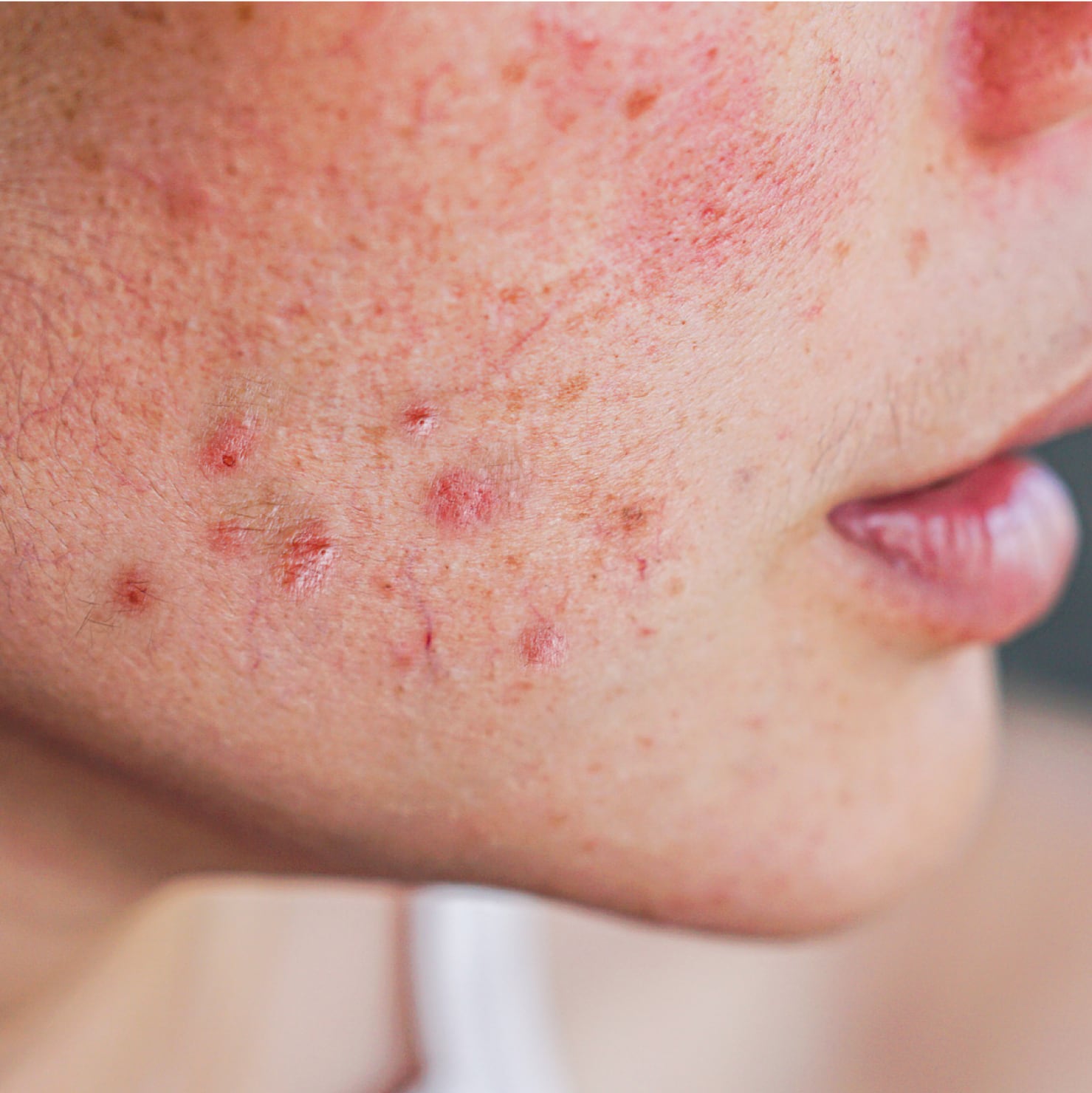
Acne
Guide to Acne: Grades, Treatments, and What to Avoid
Introduction
Understanding the Grades of Acne
1. Grade I – Mild Acne:
– Occasional small papules (red, inflamed bumps) or pustules (pus-filled bumps).
– Minimal scarring.
2. Grade II – Moderate Acne:
– Numerous papules and pustules.
– Possible early signs of scarring.
3. Grade III – Moderately Severe Acne:
– Occasional larger, painful nodules (deep, solid lumps under the skin).
– Increased risk of scarring.
4. Grade IV – Severe Acne:
– Extensive inflammation.
– High risk of scarring, including hypertrophic or keloid scars.
Lifestyle Changes
Hydration
Stress Management
Sleep
Diet
Dietary Changes:
Nutrition plays a crucial role in managing acne. Consider adopting an anti-inflammatory diet rich in the following:
Foods to Include:
– Omega-3 fatty acids (found in fatty fish, flaxseeds, and walnuts) have anti-inflammatory properties.
– Antioxidant-rich foods like berries, spinach, and green tea help combat free radicals that can contribute to acne.
– Probiotic-rich foods like yoghurt and kefir support gut health, which can impact skin conditions.
Foods to Avoid:
– High-glycemic foods like sugary snacks and processed carbohydrates can lead to insulin spikes and worsen acne.
– Dairy products may contribute to hormonal fluctuations that trigger acne in some individuals.
– Excessive consumption of caffeine and alcohol can dehydrate the skin.
Skincare Ingredients to Use:
Salicylic Acid: Effective for mild to moderate acne, salicylic acid exfoliates the skin, unclogs pores, and reduces inflammation.
Retinoids (Retinol, Vitamin A): Encourage skin cell turnover, preventing the formation of comedones and promoting a smoother complexion.
Niacinamide (Vitamin B3): Reduces inflammation, minimises redness, and helps maintain the skin’s moisture barrier.
Tea Tree Oil:A natural antimicrobial, it can be diluted and applied topically to blemishes.
Hyaluronic Acid: Keeps the skin hydrated without clogging pores.
SkinCare to Avoid:
Fragrance-Loaded Skincare Products: Fragrances can be irritating and may exacerbate acne symptoms. Opt for fragrance-free products.
Heavy, Oil-Based Products: These can clog pores and worsen acne. Look for non-comedogenic or oil-free skincare options.
Over-Exfoliation: Exfoliation is essential; excessive exfoliation can damage the skin’s protective barrier and lead to more breakouts. Stick to a gentle exfoliation routine.
Picking and Squeezing: Avoid the temptation to pick or squeeze acne lesions, as this can lead to scarring and further inflammation.
Harsh Scrubs: Abrasive scrubs can irritate the skin and exacerbate acne. Opt for gentler exfoliation methods like chemical exfoliants.
Treatments That Can Help:
Chemical Peels: Can help improve the appearance of acne-prone skin by removing dead skin cells and unclogging pores.
LED Light Therapy: Using blue light at 405-420 nanometres effectively targets the specific bacteria (P. acnes) that contribute to the development of acne. When exposed to blue light, these bacteria produce a form of oxygen that is toxic to them, ultimately reducing their population on the skin. This antibacterial action helps prevent new acne lesions from forming.
Light and Laser Therapies: Light-based therapies, such as IPL (Intense Pulsed Light) and laser treatments, can target acne and improve skin texture. Experienced practitioners should administer these.
Conclusion
Acne can be a challenging condition to manage. Still, with the proper knowledge and strategies, achieving clearer, healthier skin is possible. Understanding the different grades of acne and tailoring your approach to your specific needs, including lifestyle, dietary changes, and skincare ingredients, can make a significant difference.
Additionally, seeking professional guidance and avoiding known triggers can help you on your journey to achieving the clear, radiant skin you desire. Remember that consistency and patience are essential when treating acne, and results may take time to become evident.
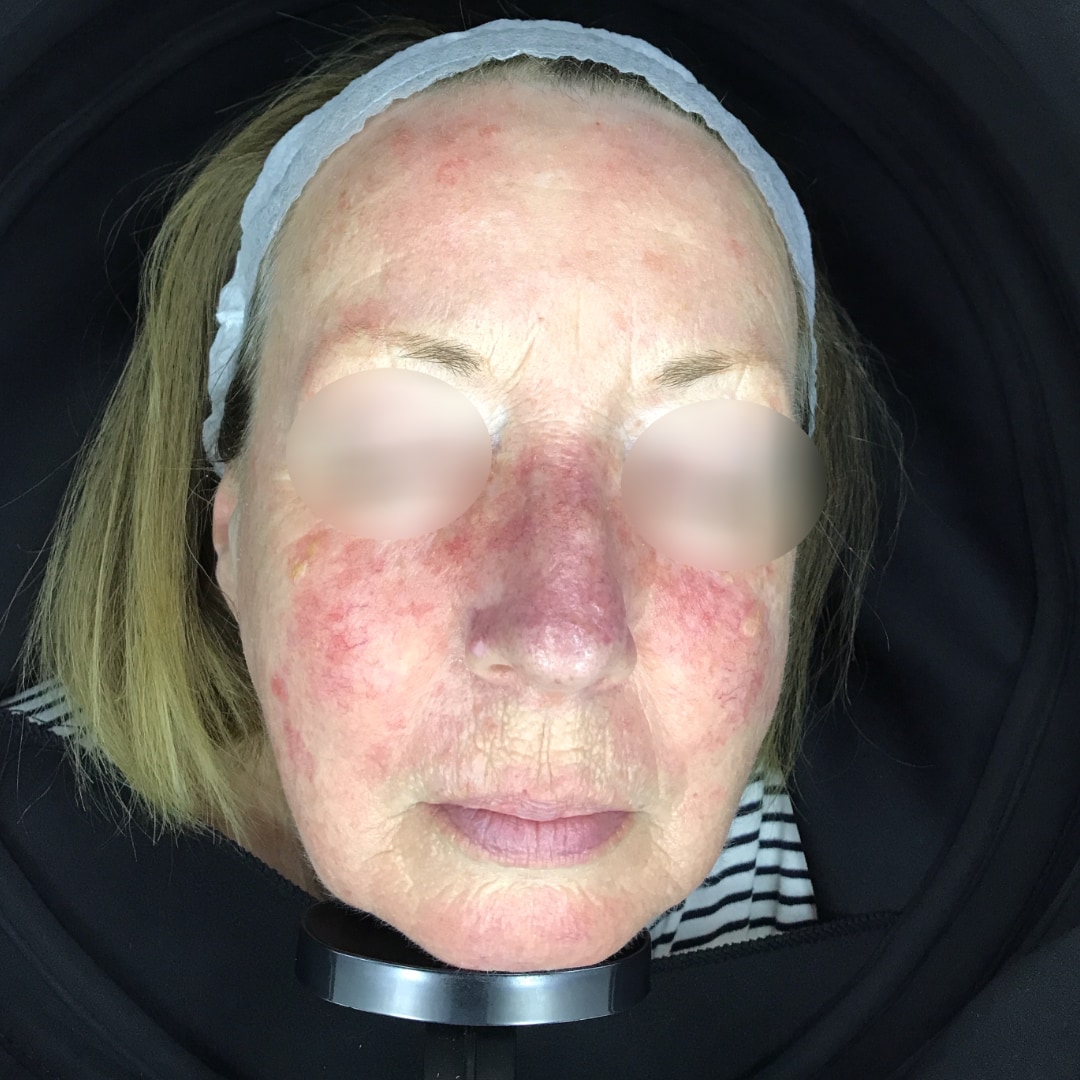
Rosacea
Understanding Rosacea: Causes, Lifestyle Effects, and Effective Treatments
What is Rosacea?
Causes and Triggers
– Hot drinks and spicy foods: These can dilate blood vessels, leading to redness.
– Gut health: Recent studies suggest a link between gut health and rosacea.
– Sun exposure: Ultraviolet rays can inflame and damage the skin.
– Extreme temperatures: Both very hot and cold weather can trigger rosacea.
– Drugs that dilate blood vessels: Certain medications can exacerbate rosacea symptoms.
Impact of Diet and Lifestyle
– Maintain a balanced gut microbiome: Probiotics and a high-fibre diet can be beneficial.
– Protect against sun exposure: Use broad-spectrum sunscreen and wear hats.
– Manage stress: Regular exercise, meditation, and adequate sleep can help.
– Avoid extreme temperatures: Protect your face in hot and cold weather.
Suitable Skin Care Ingredients
– Green tea: Anti-inflammatory and antioxidant properties.
– Niacinamide: Reduces redness and strengthens the skin barrier.
– Azelaic acid: Reduces inflammation and redness.
– Aloe Vera: Soothes irritated skin.
– Chamomile: Known for its calming effects.
Unsuitable Ingredients
– Alcohol and witch hazel: Can be overly drying.
– Fragrances and menthol: Potential irritants.
– Exfoliating acids in high concentrations: May aggravate the skin.
In-Clinic Treatments
– Gentle facials: Focus on hydration and soothing.
– LED light therapy: Red and blue light therapy can reduce inflammation and bacteria.
– IPL therapy: Can reduce redness and visible blood vessels.
Conclusion
Rosacea is a complex condition, but with careful management of diet, lifestyle, skincare, and professional treatments, its symptoms can be effectively controlled.
It’s always advisable to consult with a skin expert to tailor the approach to your specific needs.
Would you like some help with your skin?
Contact Me
If you can’t find what you’re looking for, ask me a question here;
